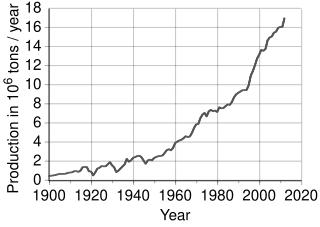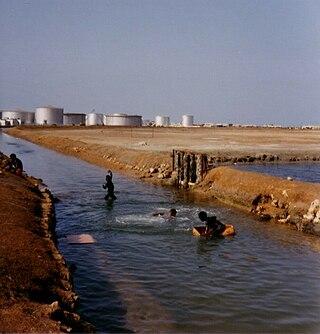Related Research Articles
Solwezi is a town in Zambia. It is the provincial capital of the mineral-rich North-Western Province. Solwezi is also the administrative capital of Solwezi District, one of the eleven districts in the North-Western Province.

First Quantum Minerals is a Canadian-based mining and metals company whose principal activities include mineral exploration, development and mining. Its main product is copper, which accounts for 80% of revenues as of 2016.

Mining in Japan is minimal because Japan does not possess many on-shore mineral resources. Many of the on-shore minerals have already been mined to the point that it has become less expensive to import minerals. There are small deposits of coal, oil, iron and minerals in the Japanese archipelago. Japan is scarce in critical natural resources and has been heavily dependent on imported energy and raw materials. There are major deep sea mineral resources in the seabed of Japan. This is not mined yet due to technological obstacles for deep sea mining.

Mining in Iran is still under development, yet the country is one of the most important mineral producers in the world, ranked among 15 major mineral-rich countries, holding some 68 types of minerals, 37 billion tonnes of proven reserves and more than 57 billion tonnes of potential reserves worth $770 billion in 2014. Mineral production contributes only 0.6 per cent to the country's GDP. Add other mining-related industries and this figure increases to just four per cent (2005). Many factors have contributed to this, namely lack of suitable infrastructure, legal barriers, exploration difficulties, and government control.

Eurasian Natural Resources Corporation PLC (ENRC) was a public, Kazakhstan/Central African-focused, multinational leading diversified natural resources company headquartered in London, United Kingdom. It had activities in integrated mining, processing, energy, logistics and marketing.

Mining in Brazil is centered on the extraction of iron, copper, gold, aluminum, manganese, tin, niobium, and nickel. About gemstones, Brazil is the world's largest producer of amethyst, topaz, agate and is a big producer of tourmaline, emerald, aquamarine, garnet and opal.

Peak copper is the point in time at which the maximum global copper production rate is reached. Since copper is a finite resource, at some point in the future new production from mining will diminish, and at some earlier time production will reach a maximum. When this will occur is a matter of dispute. Unlike fossil fuels, copper is scrapped and reused, and it has been estimated that at least 80% of all copper ever mined is still available.
Franco-Nevada Corporation is a Toronto, Ontario, Canada-based, gold-focused royalty and streaming company with a diversified portfolio of cash-flow producing assets. It is traded on the Toronto Stock Exchange and New York Stock Exchange.
Equinox Minerals is a mining and exploration company with corporate offices in Perth, Australia and Toronto, Ontario, Canada. It has operations in Peru and Australia. In Zambia it owned the Lumwana Mining Company, but that was bought by Barrick Gold in 2011. Through Liontown Resources Limited and Alturas Minerals Corp., the company has gold and copper-gold exploration interests in Peru and Australia. The Lumwana project which had enough reserves to be productive for 37 years, cost the company one billion dollars to develop. In Zambia it has been credited with supporting social development through projects which aim to build schools, attract professionals to areas around its mine sites. 2010 copper production was 323.4 million pounds 68% higher than in 2009.
The mining landscape in Zambia covers production of multiple mineral raw materials, including copper, cobalt, gold, nickel, manganese, emeralds, beryllium, myriad gemstones, sulfur, zinc, coal, iron ore, steel, limestone, uranium and other platinum-group metals. Mining has long been a significant primary sector industry and contributor to the Zambian economy by providing export income, royalty payments and employment.
Bwana Mkubwa is a settlement and a mine in Copperbelt Province, Zambia. It is the oldest mine in Zambia's Copperbelt region. As a settlement with no municipal status, it became a locale due to the abundant copper deposits found in the area. Today, it is part of Ndola.
Lonshi Mine is a copper mine in Katanga Province of the Democratic Republic of the Congo, to the southeast of Ndola, Zambia.
Mopani Copper Mines PLC ("Mopani") is a Zambian registered company 100% owned by ZCCM Investment Holdings.
Mining in North Korea is important to the country's economy. North Korea is naturally abundant in metals such as magnesite, zinc, tungsten, and iron; with magnesite resources of 6 billion tonnes, particularly in the North and South Hamgyong Province and Chagang Province. However, often these cannot be mined due to the acute shortage of electricity in the country, as well as the lack of proper tools to mine these materials and an antiquated industrial base. Coal, iron ore, limestone, and magnesite deposits are larger than other mineral commodities. Mining joint ventures with other countries include China, Canada, Egypt, and South Korea.
Cobre Panamá is a large open-pit copper mine in Panama, located 120 kilometres west of Panama City and 20 kilometres from the Caribbean Sea coast, in the district of Donoso, Colon province, in the Republic of Panama. The mine consists of four zones totalling 13,600 hectares. The main deposits are at Balboa, Botija, Colina and Valle Grande. With 3.1 billion tonnes of proven and probable reserves, Cobre Panama is one of the largest new copper mines opened globally since 2010. It is located next to the Petaquilla mine.
Kansanshi mine is a large copper and gold mine located in Solwezi in the North-Western Province of Zambia. The mine is approximately 14 kilometers north the town of Solwezi. Kansanshi is one of the largest copper reserves in Zambia, with estimated reserves of 727 million tonnes of ore graded at 0.86% copper.
The Carrapateena mine is a large copper mine under development in South Australia's Far North region 100 km southeast of Olympic Dam and approximately 160km north of Port Augusta. Carrapateena represents one of the largest copper reserves in Australia and in the world having estimated reserves of 292 million tonnes of ore grading 1.31% copper and 3.64 million oz of gold. It was discovered by explorer and metallurgist Rudie Gomez in 2005. The project was acquired by OZ Minerals in 2011, and the project was referred to the EPBC Act for Federal environmental approval in 2012. Construction of the decline to access the mine commenced in 2016. The mining technique used to extract the ore is sub-level caving.

The mining industry of Sudan is mostly driven by extraction fuel minerals, with petroleum accounting for a substantial contribution to the country's economy, until the autonomous region of Southern Sudan became an independent country in July 2011. Gold, iron ore, and base metals are mined in the Hassai Gold Mine and elsewhere. Chromite is another important mineral extracted from the Ingessana Hills. Other minerals extracted are gypsum, salt, and cement. Phosphate is found in Mount Kuoun and Mount Lauro in eastern Nuba. Reserves of zinc, lead, aluminium, cobalt, nickel in the form of block sulfides, and uranium are also established. Large reserves of iron ore have been established.

The European mining industry has a long tradition. Although the continent's mining earns for a small share of GDP, it provides a large and significant share of the world-wide production.
Kalumbila Mine is a copper mine in Kalumbila District, North-Western Province, Zambia. It was formed in 2010 and is one of the four copper mines in Zambia. As of 2018, it was the fourth largest mining employer in Zambia with 11 000 workers. Kalumbila is also the name of the town where the mine is situated.
References
- ↑ "Reserves & Resources". first-quantum.com. 2013. Retrieved 2013-06-21.
- 1 2 3 "First Quantum says new Zambia mine, smelter to cost $2.4bn". Mining Weekly. 26 March 2012. Retrieved 19 November 2018.
- 1 2 "First Quantum Minerals launches $2.1 bln Zambia copper mine". Reuters. 28 August 2015. Archived from the original on August 31, 2015. Retrieved 19 November 2018.
- 1 2 "Countries Push to Extract More Cash from Big Mining Companies". The Wall Street Journal. 18 November 2018. Retrieved 19 November 2018.